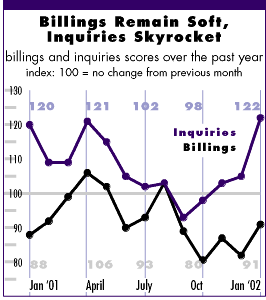
Given focus on recruiting clients, marketing has added importance this year

by Kermit Baker, PhD, Hon. AIA
AIA Chief Economist
Billings at architecture firms continued to slow in January, although the pace of the decline moderated substantially from the sharp downturn of the last quarter of 2001. For January, one out of five firms reported an increase in billings, the largest share since last August. Firms in all major regions reported declines in billings, although the steepest were among firms in the Northeast. Firms concentrating in the residential work were the only category reporting gains in January.
 By
contrast, inquiries for new projects shot up in January—the sharpest
jump in almost two years. While the strongest gains in inquiries were
among firms specializing in residential activity, firms of all specializations
reported substantial improvement.
By
contrast, inquiries for new projects shot up in January—the sharpest
jump in almost two years. While the strongest gains in inquiries were
among firms specializing in residential activity, firms of all specializations
reported substantial improvement.
Recession with signs
of recovery
The economy apparently remained in recession in January, although there
are signs of impending recovery. Business payrolls declined by 89,000
in January, even though the national unemployment rate declined to 5.6%
in January from 5.8% in December. Construction numbers continue to be
weak on the commercial/industrial side (office vacancy rates have increased
sharply over the past year) and strong for institutional sectors.

The early estimate of gross domestic product for the fourth quarter of last year was surprisingly strong. Although the 0.2% annualized rate of growth is miniscule, it is encouraging when you consider that most analysts were expecting another significant decline. Strong consumer spending—particularly for cars and homes at current low interest rates—was the major reason for the increase. However, unexpected gains in federal spending also helped fuel growth.
 There
is evidence that the economy is close to bottoming out. The Federal Reserve
Board declined to lower interest rates at its late January meeting, the
first meeting in over a year at which the board didn't lower rates. Most
analysts feel that the economy will be back into recovery mode by the
second quarter of the year, if not by the end of this current quarter.
There
is evidence that the economy is close to bottoming out. The Federal Reserve
Board declined to lower interest rates at its late January meeting, the
first meeting in over a year at which the board didn't lower rates. Most
analysts feel that the economy will be back into recovery mode by the
second quarter of the year, if not by the end of this current quarter.
Client recruitment
especially important now
With the construction outlook so unsettled this year, firms are feeling
the need to recruit additional clients. Over half of firms indicate that
recruiting new clients is very important in meeting the firm's financial
targets for the year. An additional 28% of firms rated new client recruitment
as important.
 In
spite of the importance of client recruitment, almost a third of firms
do not have a marketing plan in place. Of those firms with plans, more
than half indicate that the plan is not a formal written document but
rather a set of revenue goals and target markets. While all firms with
annual revenues over $5 million have a marketing plan in place, only about
half of firms with annual billings under $1 million report such a document.
Over three-quarters of firms concentrating in the institutional sector
have marketing plans.
In
spite of the importance of client recruitment, almost a third of firms
do not have a marketing plan in place. Of those firms with plans, more
than half indicate that the plan is not a formal written document but
rather a set of revenue goals and target markets. While all firms with
annual revenues over $5 million have a marketing plan in place, only about
half of firms with annual billings under $1 million report such a document.
Over three-quarters of firms concentrating in the institutional sector
have marketing plans.
Copyright 2002 The American Institute of Architects. All rights reserved.
![]()
|
Work-on-the-Boards survey participants say . . . "Diversification into new market sectors continues to fuel
our growth." "Instead of long-term dips and rises, we are seeing lots of
small but dramatic dips and jumps." "The institutional market is very robust. As a result, we
have the largest backlog in the history of the firm." Stand Up and Be Counted—Join the Work-on-the-Boards Survey Team Be one of the hundreds of firm principals who spend just a few minutes each month answering a fax-back survey (usually two questions). For more information on how to participate, send an email to Jennifer Schauer, call her, 202-626-7532, or send her a fax, 202-626-7527. |
|